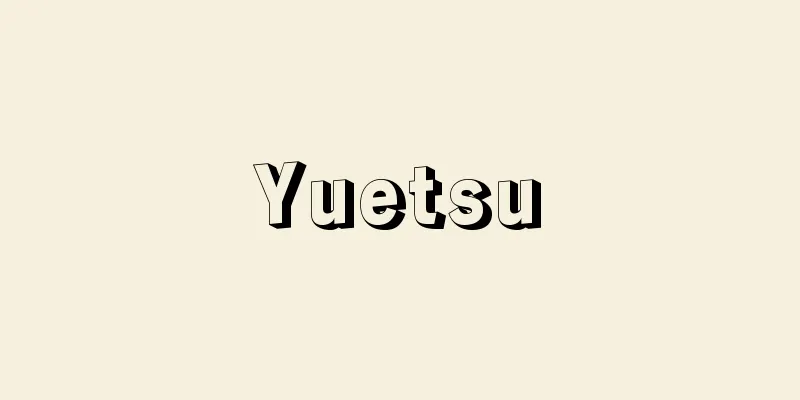Yuetsu

|
A scholar from the late Qing Dynasty in China. He was called Quyuan and was from Deqing County, Zhejiang Province. He was a Jinshi in 1850 (the 30th year of the Daoguang Era). He was acquainted with Zeng Guofan and was appointed by the editor of the Hanlin Academy to be the educational administrator of Henan, but retired at the age of 38. Despite the national crisis that followed the Taiping Rebellion, he lived a long life, living a life of study, reading, and writing with the support of Li Hongzhang and others. He took pride in his major works, "Qunjingpingui" (7 volumes each) and "Zhuzipingui" (7 volumes) and "Gushugiyijiangli" (7 volumes), all of which he inherited and developed from the work of the Wang family of Gaoyou, namely Wang Niansun and Yinzhi (father and son) ("Chunzaitang Quanshu Lu Yao"). However, it seems that his learning did not develop until the later scholars Sun Yirang, Wang Xianqian, and Zhang Binglin. He is said to have written the greatest number of works in the Qing dynasty, based on his talent and leisure time, and left behind the 480-volume "Chunzaitang Complete Works." In addition to the major works mentioned above, this includes a wide range of content, including poetry, essays, notes, plays, critiques on popular literature, and anthologies of Japanese Chinese poetry ("Dongying Poetry Selection" and "Donghai Tou Taoshu"). He also wrote popular novels such as "Seven Heroes Five Meanings." In general, he can be described as a hedonist who relied on his vast knowledge and vigorous curiosity. The literary critic Yu Pingbo is his great-grandson. [Miyauchi Tamotsu March 18, 2016] "Draft History of the Qing Dynasty, 482 volumes" ▽ "Biographies of the Great Masters of Chinese Learning in the Qing Dynasty , 6 volumes" ▽ "Biographies of 700 Famous People of the Qing Dynasty, 7 Volumes" ▽ "Biography of Master Yu" by Zhang Binglin (Taiyanwenlu, First Volume, 2 Volumes)" ▽ "An Introduction to Academic Studies in the Qing Dynasty, by Liang Qichao, translated by Ono Kazuko (Heibonsha, Toyo Bunko)" [Reference items] | | | | |Source: Shogakukan Encyclopedia Nipponica About Encyclopedia Nipponica Information | Legend |
|
中国、清(しん)末の学者。曲園と号す。浙江(せっこう)省徳清県の人。1850年(道光30)の進士。曽国藩(そうこくはん)の知遇を得て翰林(かんりん)院編修から河南学政に任じられたが、38歳で致仕(ちし)し、あたかも太平天国に続く国家存亡の世情をよそに、李鴻章(りこうしょう)らの援助のもと講学、読書、著述の生活を送って長寿を全うした。主著の『群経平議』『諸子平議』各7巻および『古書疑義挙例』7巻などはすべて、高郵(こうゆう)の王氏すなわち王念孫(ねんそん)・引之(いんし)父子の成果を継承発展したものであると自負している(『春在堂全書録要』)。しかし、その学はむしろ後学の孫詒譲(そんいじょう)、王先謙、章炳麟(しょうへいりん)をまって発展した感がある。才気と余暇にまかせての著作量は清代随一とうたわれ、『春在堂全書』480巻を残すが、これは、前記の主著のほか詩詞、随筆、筆記、戯曲、通俗文芸の評論、日本漢詩の選集(『東瀛(とうえい)詩選』『東海投桃集』)など、雑多な内容からなっている。さらに『七侠(しちきょう)五義』のような通俗小説にも筆を染めるなど、総じて該博な知識と旺盛(おうせい)な好奇心とを頼んだ快楽主義者であったと評してよいであろう。なお、文芸評論家兪平伯(ゆへいはく)はその曽孫(そうそん)である。 [宮内 保 2016年3月18日] 『『清史稿 482巻』』▽『『清代樸学大師列伝 6巻』』▽『『清代七百名人伝 7編』』▽『章炳麟著『兪先生伝』(『太炎文録 初編 2巻』)』▽『梁啓超著、小野和子訳『清代学術概論』(平凡社・東洋文庫)』 [参照項目] | | | | |出典 小学館 日本大百科全書(ニッポニカ)日本大百科全書(ニッポニカ)について 情報 | 凡例 |
>>: United States Steel [company] - US Steel
Recommend
Mycology - Kinkaku
It is a branch of biology that deals with fungi, ...
Bois Sacré (English spelling) BoisSacre
...A district of Los Angeles located approximatel...
Yamaguchi Line
The name of the track of the West Japan Railway C...
Savings insurance - Chochikuhoken
A type of survival insurance under life insurance....
Tool - Kako
〘Noun〙① A hook used to fasten leather belts, etc. ...
Shoshi - Chief
〘Noun〙① An official of a government office. ※Shoku...
Fundoshi (loincloth) - Fundoshi
A cloth that covers a man's crotch area. Also ...
Reforestation
...Although it is sometimes used almost the same ...
anthocyanin
...It began when LC Marquart named the blue pigme...
Obi Bandicoot - Obi Bandicoot
...General term for a rabbit-sized or slightly sm...
Shell structure - shell structure
Shells are thin, curved walls that resist externa...
Lago Nahuel Huapí (English spelling)
A lake in the southwest of Argentina. In the Patag...
Volcanic gas - Kazan gas (English spelling)
Gas that erupts from volcanoes. It is also called ...
Keicho Nikkenroku - Record of Keicho Period
The diary of the noble and Confucian scholar Funah...
découpage (English spelling)
...It goes without saying that collage is also us...









